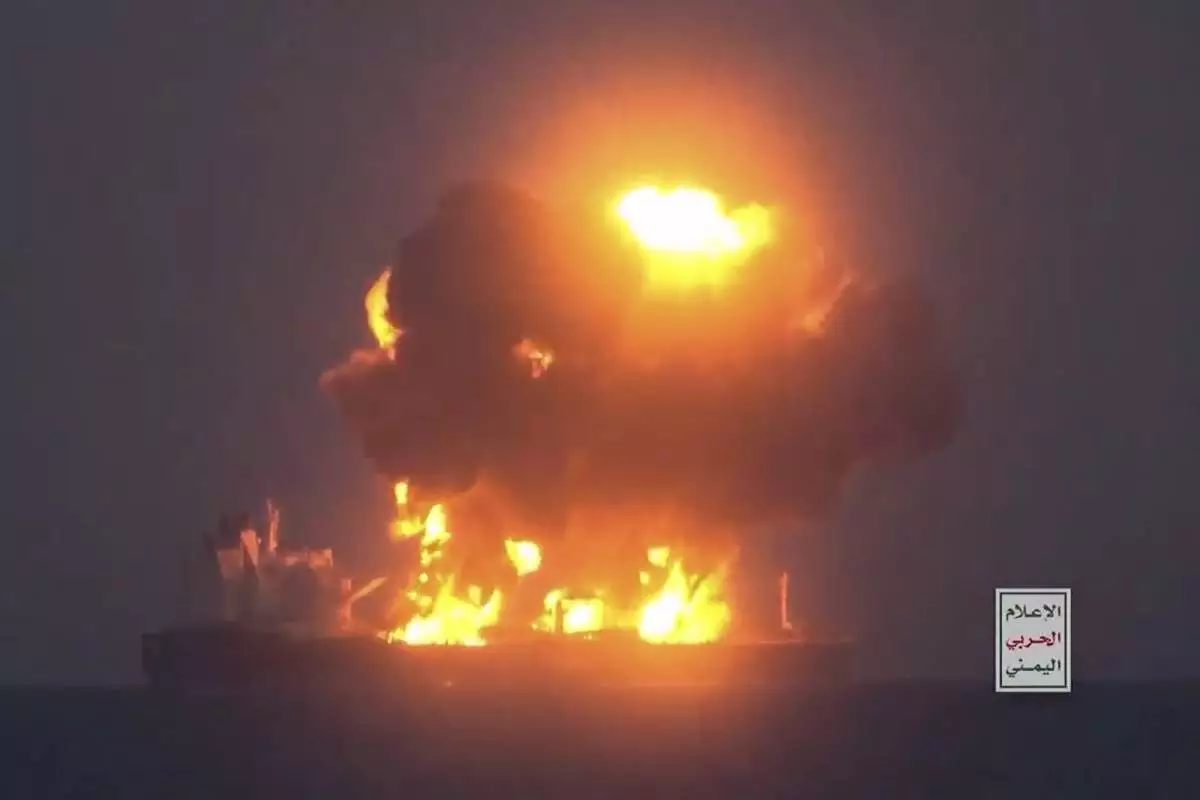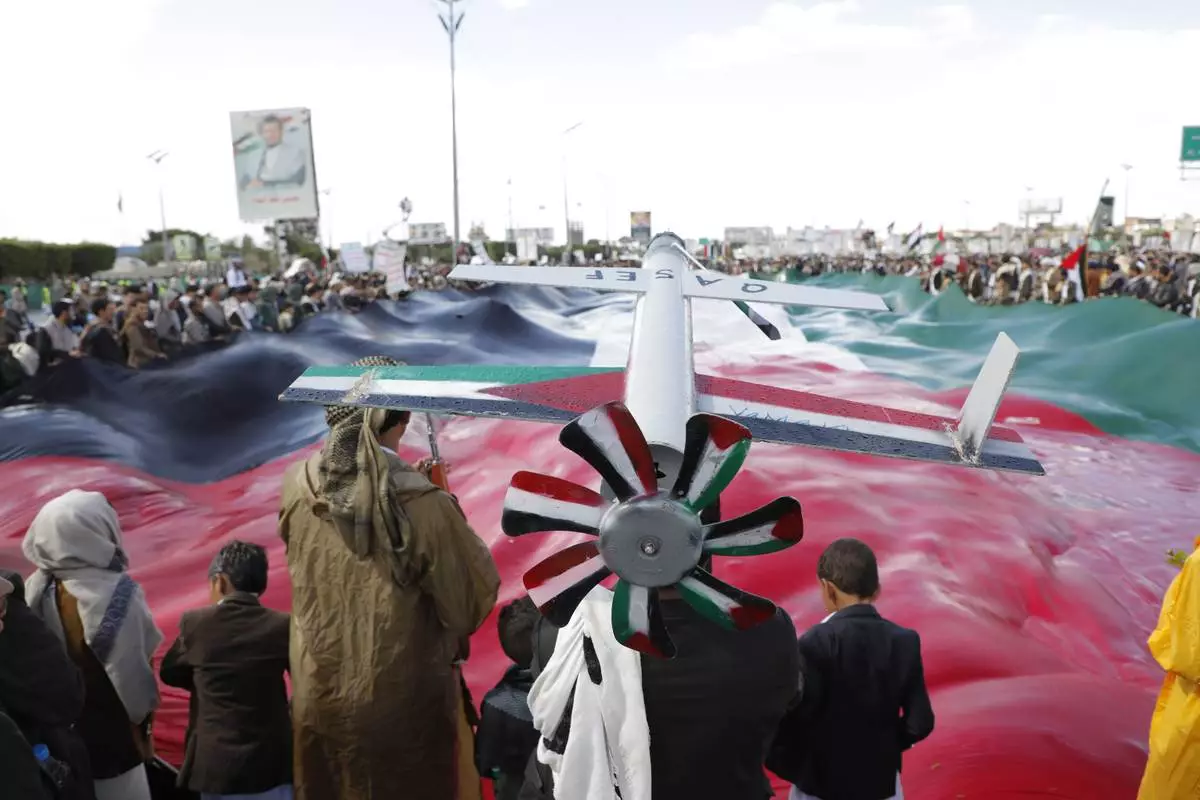DUBAI, United Arab Emirates (AP) — Fires broke out Friday on a Greek-flagged oil tanker previously attacked by Yemen's Houthi rebels this week, with the vessel now appearing to be adrift in the Red Sea, authorities said.
It wasn't immediately clear what had happened to the oil tanker Sounion, which had been abandoned by its crew on Thursday and reportedly anchored in place.
Click to Gallery
DUBAI, United Arab Emirates (AP) — Fires broke out Friday on a Greek-flagged oil tanker previously attacked by Yemen's Houthi rebels this week, with the vessel now appearing to be adrift in the Red Sea, authorities said.
Houthi supporters attend an anti-Israel and anti-US rally in Sanaa, Yemen, Friday, Aug. 23, 2024. (AP Photo/Osamah Abdulrahman)
Houthi supporters attend an anti-Israel and anti-US rally in Sanaa, Yemen, Friday, Aug. 23, 2024. (AP Photo/Osamah Abdulrahman)
Houthi supporters attend an anti-Israel and anti-US rally in Sanaa, Yemen, Friday, Aug. 23, 2024. (AP Photo/Osamah Abdulrahman)
Houthi supporters attend an anti-Israel and anti-US rally in Sanaa, Yemen, Friday, Aug. 23, 2024. (AP Photo/Osamah Abdulrahman)
The Greek-flagged oil tanker Sounion is seen heading into the Finnart Ocean Terminal in the United Kingdom on Nov. 29, 2017. The Sounion traveling through the Red Sea came under repeated attack Wednesday, Aug. 21, 2024, leaving the vessel "not under command" and drifting ablaze after an assault suspected to have been carried out by Yemen's Houthi rebels, the British military said. (David Mackinnon via AP)
The Greek-flagged oil tanker Sounion is seen heading into the Finnart Ocean Terminal in the United Kingdom on Nov. 29, 2017. The Sounion traveling through the Red Sea came under repeated attack Wednesday, Aug. 21, 2024, leaving the vessel "not under command" and drifting ablaze after an assault suspected to have been carried out by Yemen's Houthi rebels, the British military said. (David Mackinnon via AP)
The Houthis didn't immediately acknowledge the fire. The rebels are suspected to have gone back and attacked at least one other vessel that later sank as part of their monthslong campaign against shipping in the Red Sea over the ongoing Israel-Hamas war in the Gaza Strip. The attacks have disrupted a trade route that typically sees $1 trillion in goods pass through it annually.
The British military's United Kingdom Maritime Trade Operations center reported the fires in a note to mariners on Friday night.
“UKMTO have received a report that three fires have been observed on vessel,” the center said. “The vessel appears to be drifting.”
A United States defense official, speaking on condition of anonymity to discuss intelligence matters, said American officials were aware of the fires and continued to monitor the situation.
The vessel had been staffed by a crew of 25 Filipinos and Russians, as well as four private security personnel, who were taken by a French destroyer to nearby Djibouti, the European Union's Aspides naval mission in the Red Sea said Thursday.
The Sounion has 150,000 tons of crude oil aboard and represents a “navigational and environmental hazard,” the mission warned. “It is essential that everyone in the area exercises caution and refrains from any actions that could lead to a deterioration of the current situation.”
Late Friday night, the Houthis released footage of an explosion striking the Sounion, their fighters on the water in the distance chanting the group's slogan: “God is the greatest; death to America; death to Israel; curse the Jews; victory to Islam.”
A frame-by-frame analysis of the video conducted by The Associated Press suggested three simultaneous explosions struck the deck of the Sounion. That signature suggests an attack conducted by planted explosives, rather than a strike by missile or drone.
The Houthis have targeted more than 80 vessels with missiles and drones since the war in Gaza started in October. They seized one vessel and sank two in the campaign that also killed four sailors. One of the sunken vessels, the Tutor, went down after the Houthis planted explosives aboard it, after its crew abandoned the ship due to an earlier attack, the rebel group later acknowledged.
Other missiles and drones have either been intercepted by a U.S.-led coalition in the Red Sea or failed to reach their targets.
The rebels maintain that they target ships linked to Israel, the U.S. or the U.K. to force an end to Israel's campaign against Hamas in Gaza. However, many of the ships attacked have little or no connection to the conflict, including some bound for Iran.
As Iran threatens to retaliate against Israel over the assassination of Hamas leader Ismail Haniyeh in Tehran, the U.S. military told the USS Abraham Lincoln aircraft carrier strike group to sail more quickly to the area. Early Thursday, the U.S. military’s Central Command said that the Lincoln had reached the waters of the Middle East, without elaborating.
Washington also has ordered the USS Georgia-guided missile submarine to the region, while the USS Theodore Roosevelt aircraft carrier strike group was in the Gulf of Oman.
Additional F-22 fighter jets have flown into the region and the USS Wasp, a large amphibious assault ship carrying F-35 fighter jets, is in the Mediterranean Sea.
Early Saturday, the U.S. military's Central Command said it had destroyed a Houthi missile system in Yemen over the last 24 hours.

This frame grab from video released by the Ansar Allah Media Office, the media arm of Yemen's Houthi rebels, on Friday, Aug. 23, 2024, shows what the Houthis describe as one of their attacks on the Greek-flagged oil tanker Sounion in the the Red Sea. The logo in the bottom righthand corner of the image reads in Arabic: "Yemeni War Media." (Ansar Allah Media Office via AP)

Houthi supporters attend an anti-Israel and anti-US rally in Sanaa, Yemen, Friday, Aug. 23, 2024. (AP Photo/Osamah Abdulrahman)

Houthi supporters attend an anti-Israel and anti-US rally in Sanaa, Yemen, Friday, Aug. 23, 2024. (AP Photo/Osamah Abdulrahman)

Houthi supporters attend an anti-Israel and anti-US rally in Sanaa, Yemen, Friday, Aug. 23, 2024. (AP Photo/Osamah Abdulrahman)

Houthi supporters attend an anti-Israel and anti-US rally in Sanaa, Yemen, Friday, Aug. 23, 2024. (AP Photo/Osamah Abdulrahman)

The Greek-flagged oil tanker Sounion is seen heading into the Finnart Ocean Terminal in the United Kingdom on Nov. 29, 2017. The Sounion traveling through the Red Sea came under repeated attack Wednesday, Aug. 21, 2024, leaving the vessel "not under command" and drifting ablaze after an assault suspected to have been carried out by Yemen's Houthi rebels, the British military said. (David Mackinnon via AP)

The Greek-flagged oil tanker Sounion is seen heading into the Finnart Ocean Terminal in the United Kingdom on Nov. 29, 2017. The Sounion traveling through the Red Sea came under repeated attack Wednesday, Aug. 21, 2024, leaving the vessel "not under command" and drifting ablaze after an assault suspected to have been carried out by Yemen's Houthi rebels, the British military said. (David Mackinnon via AP)
BOSTON (AP) — A study that explores the feasibility of using pigeons to guide missiles and one that looks at the swimming abilities of dead fish were among the winners Thursday of this year’s Ig Nobels, the prize for comical scientific achievement.
Held less than a month before the actual Nobel Prizes are announced, the 34th annual Ig Nobel prize ceremony at the Massachusetts Institute of Technology was organized by the Annals of Improbable Research magazine’s website to make people laugh and think. Winners received a transparent box containing historic items related to Murphy’s Law — the theme of the night — and a nearly worthless Zimbabwean $10 trillion bill. Actual Nobel laureates handed the winners their prizes.
“While some politicians were trying to make sensible things sound crazy, scientists discovered some crazy-sounding things that make a lot of sense,” Marc Abrahams, master of ceremonies and editor of the magazine, said in an e-mail interview.
The ceremony started with Kees Moliker, winner of 2003 Ig Noble for biology, giving out safety instructions. His prize was for a study that documented the existence of homosexual necrophilia in mallard ducks.
“This is the duck,” he said, holding up a duck. “This is the dead one.”
After that, someone came on stage wearing a yellow target on their chest and a plastic face mask. Soon, they were inundated with people in the audience throwing paper airplanes at them.
Then, the awards began — several dry presentations which were interrupted by a girl coming on stage and repeatedly yelling “Please stop. I'm bored.” The awards ceremony was also was broken up by an international song competition inspired by Murphy's Law, including one about coleslaw and another about the legal system.
The winners were honored in 10 categories, including for peace and anatomy. Among them were scientists who showed a vine from Chile imitates the shapes of artificial plants nearby and another study that examined whether the hair on people's heads in the Northern Hemisphere swirled in the same direction as someone's hair in the Southern Hemisphere.
Other winners include a group of scientists who showed that fake medicine that causes side effects can be more effective than fake medicine that doesn't cause side effects and one showing that some mammals are cable of breathing through their anus — winners who came on stage wearing a fish-inspired hats.
Julie Skinner Vargas accepted the peace prize on behalf of her late father B.F. Skinner, who wrote the pigeon-missile study. Skinner Vargas is also the head of the B.F. Skinner Foundation.
“I want to thank you for finally acknowledging his most important contribution,” she said. “Thank you for putting the record straight.”
James Liao, a biology professor at the University of Florida, accepted the physics prize for his study demonstrating and explaining the swimming abilities of a dead trout.
“I discovered that a live fish moved more than a dead fish but not by much,” Liao said, holding up a fake fish. “A dead trout towed behind a stick also flaps its tail to the beat of the current like a live fish surfing on swirling eddies, recapturing the energy in its environment. A dead fish does live fish things.”

Professor James Liao displays a stuffed fish while accepting a prize for physics for demonstrating and explaining the swimming abilities of a dead trout during a performance at the Ig Nobel Prize ceremony at Massachusetts Institute of Technology in Cambridge, Mass., Thursday, Sept. 12, 2024. (AP Photo/Steven Senne)

A team of researchers perform a demonstration during a performance showing that many mammals are capable of breathing through their anus while accepting the 2024 Ig Nobel prize in physiology at the Ig Nobel Prize ceremony at Massachusetts Institute of Technology, in Cambridge, Mass., Thursday, Sept. 12, 2024. (AP Photo/Steven Senne)

People in the audience throw paper airplanes toward the stage during a performance at the Ig Nobel Prize ceremony at Massachusetts Institute of Technology in Cambridge, Mass., Thursday, Sept. 12, 2024. (AP Photo/Steven Senne)

FILE - Students walk past the "Great Dome" atop Building 10 on the Massachusetts Institute of Technology campus in Cambridge, Mass, April 3, 2017. (AP Photo/Charles Krupa, File)



























